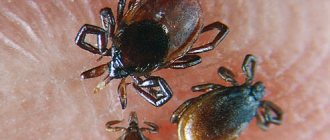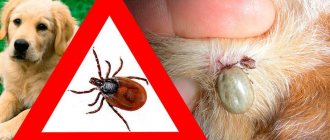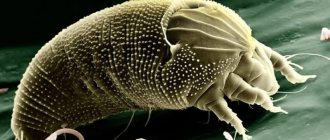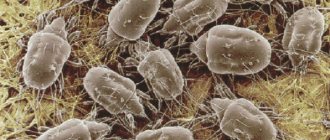Ticks are arachnid arthropod insects. There are about 48 thousand of their varieties in the world. Most of them feed on organic matter and produce humus. But among others, there are species that pose a danger to human health. Some are capable of causing respiratory diseases, others are carriers of infectious agents that lead to serious illness and even death. Let's try to figure out whether such mites can live in an apartment.
Types of ticks in the house
Several species of these dangerous arachnids can exist in the vicinity of humans. Moreover, some of them not only live nearby, but also prefer to feed on the blood of people and pets. And the waste products of others cause the development of allergies.
Dusty
This mite is most often found in apartments. The insect is small in size from 0.1 to 0.5 mm, so it is impossible to see it with the naked eye. The mite feeds on dust, which is why it got its name. The insect is widespread on all continents. 1 g of dust can contain up to 150 species of dust mites.
Dusty
The life cycle of the insect is 65-80 days. Dust mites can live and reproduce in an apartment all year round. Optimal conditions: temperature within +18…+250С and high humidity.
A female dust mite makes hundreds of clutches throughout her life, each containing 60 eggs. The waste products of this species are one of the causes of the development of bronchial asthma.
Ixodes
This type of tick is considered one of the largest, its body size reaches 2.5-4.5 mm. The color of the insect is brownish-brown. Ixodid ticks are found on all continents except Antarctica and are able to live in any climate zone. This species belongs to the blood-sucking category. Insects live on the street, in parks, gardens, forests, hiding in thickets of grass and bushes, waiting for their prey. They prefer warm, humid places.
Ixodid ticks are especially active in spring and late summer. But some individuals cannot sleep even in winter. Forest ticks enter apartments on the fur of pets, people’s clothing, in baskets with mushrooms, and also with bouquets of wild flowers.
How long a forest tick lives in an apartment depends on the availability of favorable conditions. For full life, it needs soil and moisture. Therefore, it cannot exist in a human home for a long time, but even its short-term stay in the house threatens residents with serious health consequences.
Ixodes
Bed
This type of arachnid insect belongs to the category of synanthropes. The bed mite has a microscopic size, its body length reaches no more than 0.5 mm, so it is impossible to detect it without a special device. It feeds on dead skin particles and dandruff. It is impossible to suffer from the bites of these parasites, since they do not feed on human blood. But this does not make them any less dangerous than their counterparts.
The lifespan of such insects is 65-80 days, but without food in the apartment, the tick is capable of falling into suspended animation and remaining there for four years until favorable conditions appear. The female lays from 3 to 8 thousand eggs throughout her life.
Bed
How to fight ticks
The fight against these parasites is not particularly difficult; the main factor that affects the number of ticks in your home is the cleanliness of all rooms. Regular cleaning of the premises and washing of things will reduce the number of parasites in the shortest possible time to acceptable limits.
Methods to combat dust mites:
- A vacuum cleaner with an aquafilter will allow you to get rid of most of the parasites when cleaning; you can use other types of vacuum cleaners, but the filter must be made of dense material so that mites do not fly through it. It is necessary to vacuum the room at least twice a week; you should vacuum not only carpets, but also sofas, armchairs and other upholstered furniture.
- Regular cleaning of dust from tables, cabinets and other surfaces. You should wipe with a damp cloth, or it is better to apply a special polishing agent to the varnished surfaces; it will prevent dust from sticking. Dust from cabinets and other furniture should be wiped off at least once a week.
- Washing the floors also plays a big role in eliminating dust mites; after any vacuum cleaner, there will be stains or specks of dust that hid in a corner and went unnoticed. When cleaning floors, you should wash the cloth regularly and thoroughly. Floors are washed every week.
- Clothes and bedding should be washed once a week at a water temperature of at least 60 degrees. You can add special products to kill ticks in your washing machine; they are sold in online stores.
- Ticks love high humidity, so you can try reducing the humidity in the room. Air conditioners are also used to dry the room and trap dust.
- Regular water procedures can get rid of parasites remaining on the human body.
They also use various drugs that need to be sprayed indoors to kill parasites.
Special preparations for killing ticks
Anti-tick preparations have low toxicity and are intended for spraying a room or adding to a washing machine to kill parasites that have gotten on clothes and bedding.
- Allergoff is an acaricidal product to combat dust mites in your home. Sold in 400 ml spray bottles. The product begins to act on parasites after 10 minutes, and after two hours all ticks will die. The product is also safe for people and pets.
- Allergoff for washing – intended for hand washing and machine washing at temperatures below 60 degrees. During the washing process it destroys flea larvae, dust mites and allergens.
- Easy Air is a product for combating dust mites and allergens resulting from their activity. Designed for spraying chairs, beds, carpets and other furniture on which ticks can live. The drug is completely safe for people and animals and destroys itself without polluting the environment.
- Allergen Wash - designed to be added to laundry to destroy allergens and parasites. Destroys most types of allergens (pollen, mold, and pet allergens).
Neighborhood Danger
Neighborhood with ticks is dangerous for humans, even with those insects that do not feed on blood. Bed and dust mites defecate up to 20 times a day. And it is insect excrement that contains enzymes that contribute to the development of contact allergies. Also, the chitinous shell from dead ticks, when crushed into microscopic particles, enters the air and causes irritation of the mucous membranes of the nose and mouth.
Dust and bed mites cause:
- dermatitis;
- asthma;
- tearfulness;
- rhinitis;
- sneezing;
- cough;
- itching;
- rashes.
Ixodid mites are no less dangerous to humans, although they do not appear in their homes very often, unlike bed and dust mites. These insects are carriers of diseases, and when they bite, pathogens enter the open wound, which leads to serious complications.
Ixodid ticks cause the development of:
- tick-borne encephalitis;
- borrelosis (Lyme disease);
- fevers, etc.
To avoid unpleasant consequences from various types of mites, you need to know what you can use to treat the room. This will get rid of this unpleasant neighborhood and protect all the inhabitants of the house.
Bites on the skin
What is the ixodid tick and how to destroy bed ticks?
Last Updated on 02/22/2021 by Perelomanet
Ixodid ticks or wood ticks are called hard or hard ticks because they have a hard shield or scutum, which the soft ticks of the Argasidae family lack.
Ixodid ticks bite painlessly and generally unnoticed, and remain in place until they are ready to change their skin. This process may take several days, or even weeks. Some species descend from the host and move to safety, while others remain on the host and only leave when ready to lay eggs.
Ticks are dangerous because they carry diseases, many of which are difficult to treat. To progress to the next stage of their development, they need the blood of vertebrates, such as mammals, reptiles or birds, with the exception of fish.
Ticks sit on the plant, waiting to find a host on which they can attach and whose blood they will feed on. Once they are on the desired body, they insert their skin piercing agent into the host, or secrete a special glue to stick to the host. If you think that ticks live only in nature, then you are very mistaken. Ticks can be found in the forest, park, playground, and even in your home. Therefore, if you suspect the presence of ticks at home or on your property, then you urgently need to think about treating the area for ticks. Therefore, they often order the service to destroy bed ticks and disinfect the area from ticks.
Ixodid ticks secrete anticoagulants, immunosuppressive and anti-inflammatory substances into the bite area. These substances appear to help the tick receive blood from the host without the host noticing anything. These same substances help pathogens brought by ticks to effectively take hold in the host’s body. Ticks are capable of introducing a significant number of pathogens into the human body, including bacteria, spirochetes, rickettsia, viruses, nematodes, and toxins. A single tick bite can transmit multiple pathogens.
Soft mites are usually found in animal burrows, caves, and destroyed human dwellings; they reproduce easily in hot and dry conditions. Hard mites thrive in habitats rich in vertebrate hosts. The preferred habitat of hard ticks is bushes, forests, and especially wet woodlands, places along hiking trails.
Hard ticks are more likely to parasitize people and animals than soft ticks, which is why hard ticks transmit more diseases in Russia than soft ticks. Some of these diseases are: Lyme disease, tick paralysis, anaplasmosis, tick-borne encephalitis, ehrlichoiasis.
The likelihood of contracting dangerous infections increases significantly with prolonged contact with a tick, so the first step is to carefully remove the tick (by incorrectly removing a tick, for example, by crushing or damaging it, you can infect yourself with diseases that it has not yet infected you with; in addition, the tick should be taken to the entire laboratory so that they can find out what he could have infected you with in order to quickly give you the necessary medicines). The tick should not be pulled out with bare fingers, torn, or removed with oil (it will kill the tick, leaving it on the skin).
Among the less complex diseases that infect Russian ticks is granulocytic anaplasmosis, similar to an acute respiratory infection or intestinal infection. Some tick-borne diseases can inflame the airways and lead to serious neurological damage, while others affect the skin, joints, heart and internal organs. Tick-borne encephalitis leads to brain damage.
Main habitats
Treatment should be carried out throughout the apartment, paying special attention to the places where insects usually live. Thus, mites prefer to settle and reproduce on objects that are not frequently treated with cleaning agents.
Among them:
- books;
- blankets;
- pillows;
- mattresses;
- carpets;
- cushioned furniture;
- sections of the wall behind paintings, baseboards;
- sockets;
- window frames;
- cloth;
- pet bedding;
- fabric lampshades.
Danger of house ticks
Arachnids do not bite and do not themselves pose a danger to humans, but their waste products have a negative impact. The substances present in excrement are harmful. They contain enzymes that break down human integument. Upon contact with the skin, the respiratory tract causes respiratory, contact, and food allergies.
Reaction to dust mites
The reaction can be temporary or permanent. Depends on the strength of a person’s immune system. Young children and people prone to allergies are more likely to suffer.
Signs of pests in the house:
- persistent rhinitis;
- weakness;
- headache that goes away when the person leaves the room;
- decreased ability to work;
- dry cough, especially in the morning;
- frequent sneezing;
- lacrimation;
- conjunctivitis;
- atopic dermatitis;
- asthma;
- itching on the skin;
- acariasis when parasites enter the gastrointestinal tract.
On a note!
If you are allergic to house mites, antihistamines do not help and the person constantly feels unwell. The situation can only be corrected by destroying parasites and reducing their number in the house.
Methods of disposal
You can get rid of bed mites in your apartment, as well as dust mites, with the help of special services. But calling them out requires significant material costs, so you can do it yourself, using comprehensive control measures.
The first thing you can do if there are ticks in your apartment is the following:
- clean all corners, baseboards under the ceiling, walls;
- wipe the cornices, lighting fixtures;
- wash curtains and clothes at a temperature not lower than 600C degrees;
- wipe dust from hard surfaces of furniture and paintings;
- vacuum the entire apartment;
- knock out carpets and blankets on the street;
- bathe pets;
- clean soft toys.
Bathing your pet
All these measures will help reduce the number and slow down the reproduction of insects in the apartment, but do not guarantee that they will completely die. Therefore, it is advisable to further disinfest the house against ticks. To do this, you need to use special products that have acaricidal properties.
These include:
- Allergoff spray and laundry detergent;
- concentrate and spray EASY AIR;
- aerosol Milbiol.
These preparations can be used for spraying in places where arachnids are likely to accumulate, as well as for treating objects and things. And to completely get rid of ticks in the apartment, it is necessary to additionally carry out wet cleaning with the addition of bleach. It is contained in Whiteness and ACE gel.
The product should be dissolved at the rate of 100 ml per 10 liters of water. Cleaning should be done with rubber gloves and with the windows open. And upon completion, additionally ventilate the room for another 15-20 minutes.
The most dangerous types of insect mites
Ixodid ticks are very numerous (almost 1000 species), but two species pose a real danger to humans: the taiga tick and the dog tick. The taiga tick (Ixsodes persulcatus) lives in Russia and some European countries. The dog tick (Ixsodes ricinus) is common in Europe. The dog mite is moisture-loving; its eggs can develop in an aquatic environment. Both of these species often attack humans. Adults are most active in spring; activity decreases in mid-summer. Larvae and nymphs suck blood in summer.
The body structure of both species is similar, it has 4 pairs of limbs and is protected by a shell. The oval body, 1-10 mm long, tapers towards the head and is conventionally divided into a gnathosoma (proboscis or mouthparts) and an idiosoma (abdomen). When saturated with blood, the tick acquires a spherical or ovoid shape. The cuticle covering the body of insects stretches when saturated; it is covered with special plates - scutes, by the location of which the sex of the individual can be determined (females are covered with scutes only on the front part).
The main bloodsuckers are females; the peculiarities of their physique and the ability to greatly increase in size allow them to be saturated with incredibly large volumes of blood compared to their body size. Males are smaller in size and are not able to attach for a long time. The color of a hungry parasite is yellow, brown, black. When saturated, they lighten: black insects become gray, and brown insects become pinkish. The proboscis differs in length for different types of ticks. Below the last pair of limbs on the sides there are stigmata - respiratory organs. Some species have a pair of eyes below the second pair of legs.
The digestive system of the parasite consists of: the mouth opening at the tip of the proboscis, salivary glands, pharynx, esophagus, intestines and anus.
Ticks in the sofa - how to get rid of them effectively
Getting rid of pests that have settled, for example, in a double bed is quite possible. Of course, you can try to do this yourself by purchasing chemicals and treating your interior items with them. However, the result is usually predictable and disappointing. Firstly, you need to follow safety rules for working with toxic drugs. Secondly, an allergic reaction of family members, especially children, to special substances is possible. Thirdly, it is not at all necessary that bedbugs and ticks die or leave their abode forever.
To ensure that the result of disinfection does not disappoint, for treatment against dust mites, you should seek help from experts in this field. Employees of sanitary and epidemiological stations and private organizations have the necessary knowledge, practical skills in sanitary technologies and have universal chemical means. The latest technologies are applicable in any conditions, specialists perform all procedures quickly, clearly, and carefully - treating a sofa from ticks and bedbugs, and at the same time the entire surrounding area, lasts no more than an hour. Professionals guarantee almost 100% elimination of bedbugs and ticks.
It is important to note that treating one piece of furniture in an area where unwanted insects are found is ineffective. Ticks, bedbugs and their numerous offspring nest not only in sofas, but also in cracks in the floor, joints of baseboards, corners of cabinets, bedside tables, spines of books and other inconspicuous areas.
Life cycle
Depending on the species, arachnids vary significantly in life expectancy and developmental stages. Reproduction occurs sexually. The female is often larger than the male, who in many species dies after fertilization. Typical life stages of a tick are:
- egg;
- larva;
- nymph;
- adult.
The average individual lives from several weeks to months, but there are also long-livers. These include ixodid and oribatid ticks. In winter and under unfavorable conditions, arthropods enter diapause, a state of slowing down of all processes, which allows them to survive without food.
Prevention
How to prevent the appearance of house ticks or at least reduce this probability to a minimum? It’s a completely logical question that any housewife will have. And answering it is not as difficult as it seems at first glance.
It is worth noting right away that it is simply physically impossible to get rid of such insects; they are present in any home, but it is quite possible to ensure that the population is minimal and does not affect human health in any way.
Basic tips for preventing house ticks:
- Regular wet cleaning of the room is necessary , and you should avoid accumulating dirt in the corners, because... For dust mites, hard-to-reach places are a favorite habitat.
- It is worth washing bed linen periodically , but it should be dried in the open air and stored only in dry places.
- It would be useful to periodically carry out preventive cleaning using special means ; a simple and affordable saline solution, which can be easily prepared at home, is quite suitable for this purpose.
- It is necessary to constantly tidy up typical places where dust accumulates , such as cabinets, bookshelves, stationary household appliances, etc.
- There is no need to store old pillows and mattresses in the apartment , because... they accumulate huge amounts of dust and, as a result, attract domestic parasites. Also, mattresses and pillows must be cleaned regularly using special products.
In general, you should simply maintain decent order in your home, it is recommended to use air purifiers and regularly ventilate the room. In order to protect young children from allergies, it is necessary to regularly wash their soft toys and dry them, similar to bedding outdoors.
Specialized cleaning of furniture from ticks
If you find small pests in your apartment, you should first contact a professional. It is possible to guarantee the destruction of dangerous “tenants” only using modern technologies and knowledge. Of course, you can try to do this yourself, buying various dichlorvos, anti-mite and other poisons, but the result will be short-lived and incomplete. You should treat not only, for example, the sofa mattress, but also its lower part, armrests, and linen drawer.
Experts have special technical and chemical means and use complex methods and procedures. Cleaning methods include fumigation or active fog; refrigerant or nitric oxide generation, freezing; wet disinsection with liquid insecticides; carbonation, completely enveloping the room and penetrating into all hard-to-reach cracks and microcracks. The methods used according to indications leave no chance for parasites to survive.
At the same time, general competent cleaning of upholstered furniture is carried out, which is also useful. Employees of sanitary and epidemiological stations, professionals, go to their destination, equipped with everything necessary, do their job and leave the comfort of home, cleansed of all sorts of crawling evil spirits.











